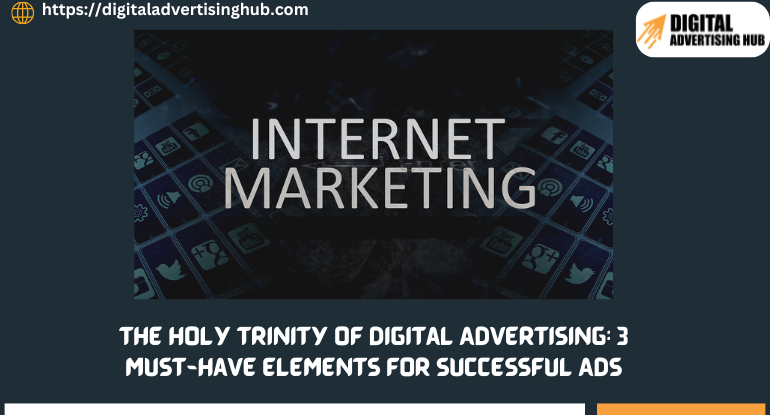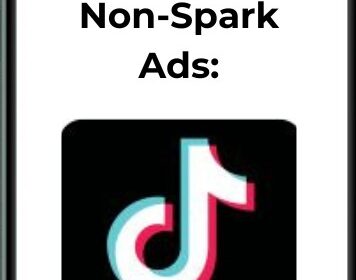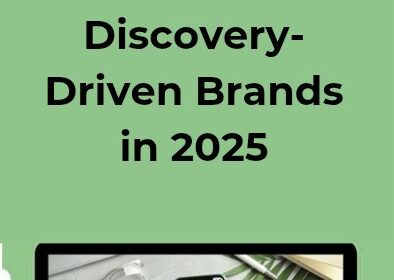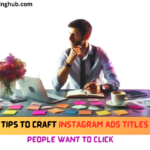Did you know that Ad spending in the Digital Advertising market is projected to reach US$740.3bn in 2024? (Source: Statista). In the competitive world of digital advertising, many businesses are pouring substantial amounts of money into platforms like Facebook and Instagram—only to see disappointing results.
Perhaps you’ve experienced this firsthand: despite having a great product or service, your ads don’t seem to resonate with your audience, and conversions are lower than expected.
Through extensive testing and millions of money invested in campaigns, I have discovered that successful ads boil down to three fundamental elements. These elements—the hook, the story, and the close—form, what I call the Holy Trinity of digital advertising Advertising. Each part serves a purpose: to capture attention, build connection, and inspire action.
In this comprehensive and straightforward article, I will break down each of these components, why they’re essential, and how mastering them can transform your campaigns from costly exercises to high-ROI investments. By the end, you’ll have the tools to create ads that not only capture attention but also generate consistent conversions, helping you turn ad spending into profitable growth.
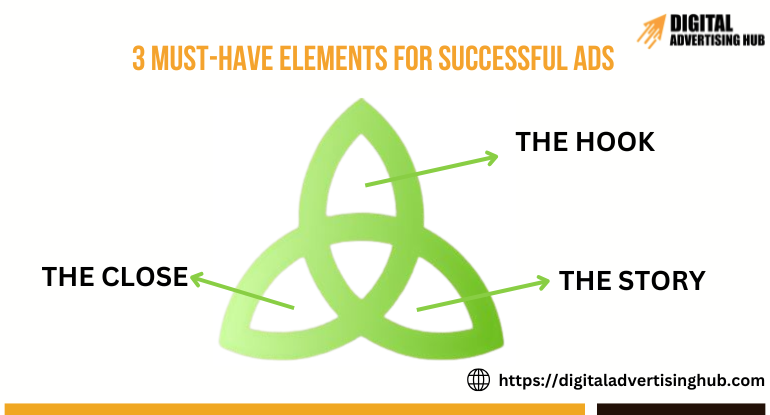
#1. The Hook: Grabbing Attention in a Crowded Space
The hook is the first fundamental element of a successful ad. Let’s start by exploring why the hook is essential, the psychology behind attention, and the techniques to create an effective hook.
Why the Hook Matters in Digital Advertising
The competition for consumer attention is fierce in today’s online advertising age. People scroll through hundreds, if not thousands, of posts and ads daily on social media platforms like Facebook, Instagram, and TikTok.
With only a split second to capture attention, the hook becomes the gateway to your ad’s success. Without a strong hook, even the most well-crafted ad won’t make an impact, as it may never be seen or given a second glance.
An ad’s hook functions as its “first impression,” determining whether viewers stop to engage or continue scrolling. So, your hook needs to stand out—not just among ads but against any content that could attract your audience’s attention.
The Psychology Behind Attention
Human attention is naturally drawn to anything that creates an emotional response, piques curiosity or resonates with existing desires or fears. Studies show that people make split-second decisions about content, often based on triggers like surprise, relatability, or urgency. These elements stimulate the brain’s dopamine release, which can reinforce engagement and memory retention.
Thus, your hook needs to connect instantly on an emotional level or stimulate curiosity. This approach leads to what’s known as a “pattern interrupt”—a disruption in their typical scrolling behavior, making them pause to see what you have to offer.
Key Techniques for Crafting Effective Hooks
There are several powerful methods to make sure your hook grabs and holds the viewer’s attention:
#1. Asking a Provocative Question: Questions are powerful attention-grabbers because they invite direct engagement. They trigger an internal dialogue that makes people pause, think, and connect personally.
Example: “What if your everyday headaches were caused by something as simple as screen glare?”
#2. Making a Bold or Shocking Statement: Statements that challenge assumptions or contain surprising facts tend to grab attention. This technique can quickly create a memorable impact.
Example: “Your screen time could be causing irreversible eye damage—here’s how to protect yourself.”
#3. Using Numbers and Statistics: Specific numbers add credibility and create intrigue, making your ad more attractive and believable. It also sets realistic expectations.
Example: “95% of screen users suffer from eye strain—are you one of them?”
#4. Leveraging Emotional Triggers: Emotional appeals resonate deeply, as people often make decisions based on feelings rather than logic. Words and phrases that emphasize relief, joy, or pain can work well.
Example: “Finally, a solution for constant headaches after a long workday!”
#5. FOMO (Fear of Missing Out): Phrases like “last chance” or “don’t miss out” leverage scarcity and urgency, prompting people to act quickly.
Example: “Limited stock—don’t miss out on protecting your eyes!”
Each of these techniques serves the purpose of engaging viewers long enough to bring them into the rest of your ad content, which leads to the next crucial element, the story.
By understanding and applying these strategies, you’ll craft hooks that attract and retain attention, building a foundation for effective storytelling in the next section of successful digital advertising.
#2. The Story: Building Emotional Connection and Holding Attention

After you’ve hooked your audience, the next step is to maintain their attention with a compelling story. The goal here is to transition from curiosity to meaningful engagement by addressing why the audience should care about your ad.
Why Stories Work in Online Advertising
People don’t just buy products—they buy feelings, solutions, and transformations. Stories help humanize a brand, making it relatable and memorable. When you tell a story that highlights how your product or service solves a specific problem, you’re creating an emotional connection that goes beyond the initial hook.
This approach taps into the psychological concept of empathy. Stories allow your audience to envision themselves benefiting from the product, which is essential for them to feel connected and invested.
Crafting an Effective Ad Story: Structure and Components
#1. Highlight the Pain Point: Start with a relatable problem or pain point that resonates with the audience. This could be a physical discomfort, an inconvenience, or even a deeper emotional struggle.
Example: For anti-glare glasses, you could start with: “After long hours in front of screens, do you find yourself squinting, experiencing headaches, or feeling fatigued?”
#2. Introduce the Solution: Present your product as the remedy to this issue. Describe how it specifically solves the problem or improves their life.
Example: “Our anti-glare glasses are specially designed with an anti-reflective coating that blocks harmful blue light, so you can work comfortably and avoid those daily headaches.”
#3. Explain the Benefits: Here, focus on the positive transformation your audience will experience by using your product. Avoid only listing features; instead, emphasize tangible benefits.
Example: “Say goodbye to eye strain and hello to clear, comfortable vision, whether you’re working late or binge-watching your favorite show.”
#4. Use Social Proof or Testimonials: Show that others have benefited from your product. Testimonials or statistics on customer satisfaction lend credibility and encourage trust.
Example: “Over 100 happy customers have said goodbye to screen-related headaches thanks to our glasses.”
#5. Tap into the Audience’s Desires or Fears: Reinforce how your product fulfills a deep-seated need or alleviates a specific fear.
Example: “Don’t let screen time ruin your eyes; take control and protect your vision today.”
Why This Approach Works
This story structure effectively addresses what’s in it for the audience (WIIFM: What’s In It For Me?), which keeps them engaged. By highlighting benefits, offering proof, and addressing underlying concerns, you’ve not only maintained their attention but also laid the foundation for a successful call to action.
Would you like to learn more about the role of storytelling? Check these resources:
–Storytelling Through Design: Crafting Compelling Narratives to Connect with Audiences Online
–Mastering Visual Storytelling
–The Ultimate Ad Copywriting Guide
#3. The Close: Driving Action with a Clear Call to Action
After captivating your audience with a hook and building rapport through storytelling, the final element—the close—is where you lead them to take action. This is your chance to convert interest into a tangible outcome, whether it’s a sale, a sign-up, or a click-through.
The Importance of a Strong Close
The close is crucial because it directs the audience on what to do next. Even if people are interested in your product, many won’t act without a clear call to action (CTA). A well-crafted CTA reduces hesitation, clarifies the next step, and, ideally, reinforces urgency or value, prompting people to take immediate action.
Key Components of an Effective Close
#1. Be Clear and Specific: Avoid vague instructions. Tell the audience exactly what to do, whether it’s “Click the link to buy now,” “Sign up for a free trial,” or “Send us a message to learn more.”
Example: “Get your anti-glare glasses now for just $500 with free delivery across the USA!”
#2. Use a Strong CTA: A good CTA doesn’t just tell the audience what to do; it gives them a reason to do it now. Phrases like “limited time only” or “while supplies last” can add urgency.
Example: “Order now—limited stock available!”
#3. Emphasize Value or Guarantee: Alleviate potential buyer concerns with guarantees or risk-free offers. Assuring them that they can request a refund or are protected if dissatisfied makes the close more compelling.
Example: “Try it risk-free! If you’re not completely satisfied, we offer a full refund.”
#4. Guide with Visual Prompts: If your ad is visual (like on social media), make the CTA prominent. Use buttons, bold text, or colored boxes to highlight your CTA visually, so it’s easy to follow and eye-catching.
#5. Create Urgency: Words that imply scarcity (e.g., “limited stock” or “only a few left”) motivate immediate action. Time-bound CTAs (“Sale ends in 24 hours”) also create a sense of urgency.
Example: “Order today for next-day delivery—limited to the first 50 customers.”
Why the Close Works
A strong close bridges interest with action by removing ambiguity and instilling confidence. When you clearly define the action, highlight value, and add urgency, you’re not only guiding the customer—you’re also giving them the nudge they often need to commit.
With these three elements of digital advertising—the hook, story, and close—you’re well-equipped to create ads that capture attention, build connection, and convert interest into action.
Conclusion
Mastering the “Holy Trinity of Digital Advertising”—the hook, story, and close—will transform your ads from ordinary to highly effective. By crafting a hook that grabs attention, a story that builds an emotional connection, and a close that drives action, you’re setting up your campaigns for success.
Each element is essential, working together to keep audiences engaged and lead them to take that final step. Invest time in refining each piece of this digital advertising framework, and watch as your ads yield better engagement, more conversions, and an increased ROI.

